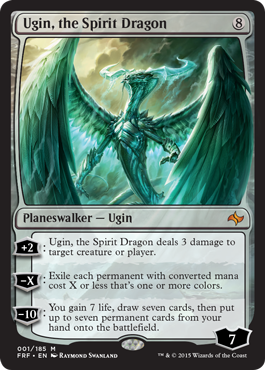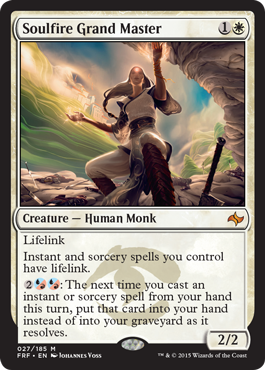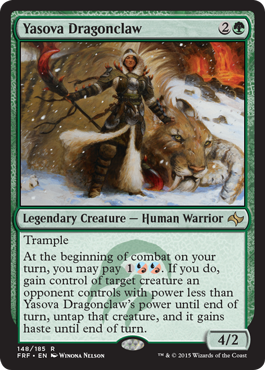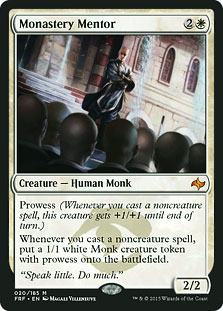Unfortunately, I haven’t been able to play any Magic in the last 2 weeks thanks to visiting family for the Holidays. While it was nice to get to see them, I did miss Magic. The worst part was that I had plenty of downtime and brought my laptop along with me; it’s just that my parents have DSL, and there were 4 young adults fighting for the limited bandwidth. When you factor in how slow MTGO usually is, it’s even worse on ~1/4th of DSL speed. Thankfully spoiler season for Fate Reforged started, which allowed me to satiate some of my Magic needs!
Theros was perhaps the worst block for Vintage since, well, maybe ever. Aside from some fringe playable cards like Swan Song, Spirit of the Labyrinth, Aegis of the Gods, Eidolon of Rhetoric, and Prophetic Flamespeaker, the block proved to be a dud for Vintage. Perhaps the best card in the entire block was Mana Confluence, which was simply a strict upgrade to City of Brass and didn’t change the format in any substantial way. After a few years of amazing cards from Zendikar through Return to Ravnica, WotC clearly dialed back the power level of Theros.
Thankfully, Khans of Tarkir Block is proving to be much more of the Zendikar-through-Return to Ravnica variety than Theros. After Khans gave us Treasure Cruise and Dig Through Time along with fringe playable stuff such as Jeskai Ascendancy, Anafenza, the Foremost, and others, with just over one week through Fate Reforged spoiler season there are already several Vintage playable cards to consider.
At the beginning of FRF spoiler season, we were treated to the newest planeswalker, Ugin:
Clearly, Ugin’s abilities are Vintage-relevant. Ugin’s +2 (Ghost Fire) ability is certainly relevant as it can kill a multitude of creatures and is a win condition in its own right. Perhaps the most relevant ability is Ugin’s –X, which closely resembles All is Dust (except that those permanents are exiled instead of going to the graveyard like All is Dust does), which can sweep the board against many opponents while keeping Ugin around to start ticking up to his ultimate. Speaking of his ultimate, it’s much like most planeswalkers in that it pretty much ends the game on the spot.
The key thing to understand about Ugin is that he is a board-control planeswalker. That is to say that his abilities are only used to control the board. They don’t interact with your opponent’s hand like Liliana of the Veil, he doesn’t provide the card advantage/filtering of Jace, the Mind Sculptor, and he doesn’t combo for the win like Tezzeret the Seeker does. That’s not to say that Ugin isn’t going to be an important piece to a competitive Vintage deck. The board sweeping ability is much more relevant against heavy creature-based decks such as Delver, Fish, and the various Hate Bears decks running around. It should be noted, however, that the current paper Vintage metagame might not be able to leverage Ugin as well as the MTGO Vintage metagame, which is much more skewed towards Delver decks. Perhaps Ugin’s biggest weakness is the fact that his –X ability ignores Workshop decks. When you add in the taxing effect of Spheres on an 8 mana spell, Ugin might be better served coming in from the sideboard against the creature decks it’s more apt to be good against.
As a colorless planeswalker, the first and immediate comparison is to Karn Liberated. Similar to when Karn was spoiled, there was a lot of early speculation that Ugin could find a home in a Metalworker Workshop deck. If we learned anything from Karn, it’s that Metalworker does not pair well with non-artifact cards. In order to get Ugin out in a reasonable amount of time (the whole point to using a mana accelerant such as Metalworker in the first place), you almost need the perfect hand. Anything less and Ugin isn’t going to come down fast enough to make a difference. For instance, to get Ugin out on Turn 2, the Workshop player would need the following: Metalworker and a Mishra’s Workshop to play on Turn 1. Then, Metalworker would need to survive your opponent’s turn to untap, which is no guarantee in this new age of Vintage where creatures (and creature removal) are more plentiful than ever. At this point, you would then need 4 artifacts (3 if 2 of them are Moxen, or 1 Mox and a Sol Ring, etc.) and Ugin in your hand in order to cast Ugin on Turn 2. Assuming you were on the play, that gives you just 1 extra card to play with. Any lands in your hand, such as Ancient Tomb will count as 1 “artifact” for purposes of casting Ugin, but Workshop and lands that only produce 1 mana will decrease the chance of being able to get to 8 mana for Ugin.
As you can see, the setup for Ugin on Turn 2 is quite the obstacle in a deck that lacks card draw and can’t filter through the top of the library to find the requisite cards. When accounting for mulligans and less than ideal draws, I don’t see Metalworker being the right path to getting an Ugin in play. So, what is the best way to “cheat” Ugin into play?
Mana Drain appears to me to be the best way to “cheat” Ugin into play. Drain is already an effective game plan for a host of decks, even if its significance has diminished in the wake of the rise of Delver decks and more specifically, Pyroblast. Due to the fact that Ugin is colorless, he can put Drain mana to better use than Jace/Tezz, the two most prominent planeswalkers in Drain decks. In Jace mirror matches, Draining a Jace on Turn 2 or 3 should provide you with enough mana to cast Ugin on the following turn. Draining a Treasure Cruise or Dig Through Time provides enough mana on their own to cast Ugin without any help. Even against Workshop decks, there are Mana Drain targets (Staff of Nin, Wurmcoil Engine, etc.) that can provide enough of a mana boost to cast Ugin, sometimes through 1-2 Spheres. Nonetheless, against Workshop, only Ugin’s Ghostfire ability will be relevant. Thankfully, it does deal with Lodestone Golem and Phyrexian Revoker in the unlikely scenario that it is able to be cast or isn’t turned off by said Revoker.
Another avenue to explore would be a UB Turbo Tezzeret style of a deck. Ancient Tomb isn’t as much of an unreasonable land in such a deck, and when combined with Voltaic Key and some number of Grim Monoliths, Sol Ring, Mana Crypt, and Mana Vault, getting to 8 mana isn’t unreasonable. Consider this shell from a deck that placed in a small tournament in Muehltal this past October as a rough start:
Turbo Tezz
|
| ||||||||
As if Ugin weren’t enough for Vintage players to discuss the merits of, the dream of a Delve Time Walk has also come true:
Considering how pushed “Delvecestral Recall” (Treasure Cruise) was, “Delve Walk” is quite underwhelming. As we’ve seen from previous Time Walk variants, WotC is very worried about having players abuse the number of extra turns they get. Temporal Mastery exiled itself, as does Trespass, which limits the number of recursion possibilities. Even without the fact that it exiles itself, the mana cost for Trespass is simply too prohibitive to see much Vintage play. Delve 8 plus 3 blue mana is quite expensive, especially for Vintage standards. In fact, it’s the 3 blue mana that hurts this card the most since it’s already established that Delving for 8 isn’t too difficult in Vintage (Cruise is Delve 7 and often leaves 1 or more cards in the graveyard after it’s cast). If WotC had priced this as Delve 9 plus 1 blue and 1 colorless (to mimic how Cruising for full Delve value mimics Ancestral Recall), I believe the card would’ve been too powerful, though it’s just theory crafting based on my experience with Cruise and Dig thus far.
Having said that, it’s still possible for Trespass to see some Vintage play as I firmly believe it is the best Time Walk variant printed yet (for Vintage purposes, at least). The closest approximation thus far has been Temporal Mastery, yet Mastery is very difficult to set up. Mastery is a dead draw in your opener as well as on your first turn. It’s possibly even a dead draw on your second turn, too. If you draw Mastery as card #2 or #3 off of Ancestral, it’s a dead card and it can never be miracled after casting a Cruise. Even if you draw it naturally and can pay for the miracle cost, it might not necessarily be the turn you would want to cast a Time Walk to get maximal value out of it or to be anything more than an Explore. To make Mastery work once it is in your hand, you would need Brainstorm to get the card out of your hand, which is restricted in Vintage, or a Jace. It’s simply too much work for little gain.
Temporal Trespass, on the other hand, doesn’t require anything other than dumping cards into your graveyard, which is something that Cruise and Dig have demonstrated to be a minor speed bump. Still, only a few decks will really benefit from the tempo gained from taking an extra turn through the resource cost that Trespass requests, which is to say that it could be useful in Delver decks. I could see Delver wanting 1-2 more Time Walks at its disposal since it is arguably the best card in their deck. Getting to swing twice with the numerous Young Pyromancer tokens is often enough to end the game, or put it within reach of a single Lightning Bolt, etc. The biggest obstacle will be deck space and how Trespass competes with Cruise for Delve resources. This will have to be something for Delver decks test out once the set is released to flesh out. My guess is that Delver decks will use 0-1 Trespass with the average being closer to 0 than to 1.
Human decks have been on the fringe of Vintage playability for the last couple of years. WotC continue to print 1-3 mana Humans in every single set that continue to push the envelope to the point where players can now customize their deck to specific goals to fight an expected metagame. Humans decks differ slightly from the traditional Hate Bears decks that have been around for years since they are less “hateful” but offer outstanding synergy with Cavern of Souls. Once Cavern of Souls was printed, every Human and other tribal races needed to be evaluated through the lens of having a creature be uncounterable, which has proven to be the strongest selling point to building Human decks.
Fate Reforged has provided Humans decks with yet another option, and one that actually provides a very real endgame, in Soulfire Grand Master. While lifegain gets a bad rap in Magic, when used as a passive ability it can make a major difference in the outcome of some matches. Here, the Grand Master herself has lifelink, but also grants it to your spells. Naturally, the best spell to give lifelink to is Lightning Bolt which basically turns it into a 1 mana lightning Helix. All other burn spells can put lifelink to good use, even the oft-maligned Sunlance.
The more important aspect to Grand Master is the ability to add the buyback cost of 2(U/R)(U/R) to any instant/sorcery spell; this includes the aforementioned Bolt as well as Ancestral Recall and Time Walk. In fact, with Time Walk and 6 mana, Grand Master turns itself into an infinite turn making machine a la Time Vault-Voltaic Key.
It’s hard to envision the perfect Humans deck for Grand Master right now since it requires a fair amount of spells to put its abilities to good use. Most Humans decks in the past have limited themselves to as few as 2-4 non-mana producing spells simply because of the dis-synergy with Cavern of Souls and Thalia, Guardian of Thraben. Often, those spells are Swords to Plowshares and Abrupt Decay, not Bolt. In fact, most Humans decks have had very little, if any, red in them at all. Thus, new builds will have to emerge and I believe they will be more controlling lists with blue permission spells combined with Bolt and Recall/Walk. Instead of having a 20+ creature package, such a deck might have 14-16 creatures. Either way, I look forward to seeing what the Humans deck players can cook up with this card.
Similar to Grand Master, another Human in Fate Reforged can stake its claim amongst the numerous options at the disposal of Humans deck builders:
Yasova has been spoiled for a while, but it’s worth discussing here briefly. Instead of pushing Humans in a new direction like Grand Master, Yasova seems to slot right into the existing Humans decks. There is a lot of crossover between what Yasova does and what Containment Priest can prevent. Therein lies the biggest question that I have about Yasova: Is it better to let your opponent play their large game-winning creatures and steal them, or is it better that they don’t get to play them at all? In the end, I believe Containment Priest does more for Humans than Yasova does. Preventing them from playing their large game-winning creatures seems like a much better strategy than hoping to untap and that Yasova survives in order to steal them.
Perhaps the most influential card that’s been spoiled in Fate Reforged is yet another Human:
The immediate comparisons to [card]Young Pyromancer[/card are certainly valid; they both provide an army in a can for an extremely efficient cost and ask for very little effort to abuse them. Once you establish that, however, the similarities end.
Let’s first examine the casting cost of Pyromancer vs. Mentor. Obviously, Mentor is 1 extra mana, but the real difference is what spells each provide access to. Using Mentor requires one to play white spells, which are rarely tempo efficient as opposed to red which can contribute significant tempo advantage. Red gives access to Bolt, Pyroblast, Ingot Chewer, and many more removal/tempo cards. White brings along the more flexible removal spell in Swords to Plowshares, but does so at the cost of tempo (life gain). Perhaps more importantly, though, is that white offers a wider range of sideboard solutions than red can. Red can fight artifacts quite well, but it can’t fight enchantments and offers nothing to fight Dredge. White allows for access to Rest in Peace, Disenchant, Containment Priest, Leyline of Sanctity, and many more. With all of this in mind, it’s safe to say that Pyromancer is more of a tempo card and Mentor is more of a control card.
Beyond the mana cost, there is also the significant difference in overall power level between Pyromancer and Mentor. Tacking on Prowess to both Mentor and the tokens is a big deal. It allows for a faster clock (from the time when both creatures hit the board, not necessarily starting from Turn 0) and means that other non-creatures spells both generate tokens and buff them. This means Moxen and Lotus produce card advantage as well as any non-creature sideboard cards you bring in (think: Grafdigger’s Cage or Rest in Peace). Casting Jace provides a free blocker in addition to the Mentor already in play. Quite frankly, Mentor is on another stratosphere when it comes to being an army in a can.
Better yet, Prowess can also be used to keep Mentor and its tokens alive while simultaneously being a bigger threat than a single Elemental token produced by Pyromancer. A common play from Delver decks is to fire off a spell in response to a removal spell on Pyromancer just to get value with a 1/1 token. With Mentor, those 1/1 tokens are a larger threat on their own due to Prowess. As far as the ways that decks have evolved to incorporate efficient sweepers like Slice and Dice, Volcanic Fallout, Pyroclasm, and/or Electrickery to fight off Pyromancer decks, those cards are simply not good enough against Mentor.
In the end, I believe that Mentor is more like Talrand Sky Summoner than Pyromancer. When evaluating Pyromancer and Mentor in a vacuum, strong tempo decks like URx Delver will still want to use Pyromancer; however, those Gush-Tendrils decks that have been utilizing Pyromancer over the last few months may want to permanently switch over to Mentor instead. Mentor’s synergy with Yawgmoth’s Will is particularly interesting as just about every nonland card in your graveyard is a 1/1 creature with Prowess providing a strong fallback “combo” option if Tendrils of Agony isn’t enough to win (due to Flusterstorm or Mindbreak Trap) or your Storm fizzles out, etc.
Another possible home for Mentor is in a Bomberman-style deck. I mentioned a couple paragraphs back that Mentor is more of a control card, and it could shine the brightest in Bomberman decks. In fact, you could probably take the Bomberman decks using Auriok Salvagers and swap out the Salvagers package for Mentors and increase the power level of the deck. Bomberman already uses Cavern of Souls and all 5 Moxen to get Trinket Mage and Salvagers into play, so Mentor already has a perfect home right there. Trinket Mage in particular is nice as it can tutor up a necessary artifact (be it a Mox/Lotus to ramp for value or find Cage, Pithing Needle, or Sensei’s Divining Top, etc.) which can then trigger Mentor if it’s already in play. Magus of the Future can help string together a series of spells to trigger Mentor to create an army or trigger Prowess several times to buff an army already in play. Consider something like this:
Mentor Bomberman
|
| ||||||||
While this deck loses the Salvagers infinite loop combo (Lotus + Spellbomb), you may notice another “infinite” combo that triggers Mentor’s token generating ability and Prowess: 2x Sensei’s Tops. With two Tops in play, you can cycle them through the top of your library once each for a single mana triggering Mentor each time. While limited to your available mana, you should only need a small handful of activations in order to create a large enough army or power them up to swing for lethal. I loved how flexible Bomberman decks were before, but this seems to take the deck to a new level. As soon as I can get my hands on some Mentors, this will be the first deck I try them out in.
Despite being more controlling than Pyromancer, there is nothing that could prevent us from playing both in the same deck! In fact, it’s possible that a UWR “Delver-less” deck might be the perfect home for both armies in a can. Due to the diminishing returns on Delver of Secrets after the first couple of turns, Mentor is an infinitely better topdeck. Over the last few months I had been testing a UWR Delver deck that utilized Stoneforge Mystic to try and leverage the speed and efficiency of Delver with the late-game power of Stoneforge and I always found Delver to be among the worst cards in the deck. Maybe swapping it out for 2-3 Mentors is a better plan? Such a deck might look something like this:
Monastery Pyromancer
|
| ||||||||
No matter what happens during the upcoming B&R announcement, Vintage is set to get shaken up once Fate Reforged is finally released. We are only halfway through spoiler season and there are already several Vintage playable cards. I’m particularly excited about Monastery Mentor. Young Pyromancer was arguably the best creature in Vintage a week ago and we now have a card that is an upgrade in nearly every aspect.
enderfall
Clan Magic Eternal
Follow me on Twitter @enderfall







What do you think of Temporal Trespass with Monastery Mentor? You mentioned the benefits of extra Time Walks for Pyromancer decks but as you say Mentor does what Pyromancer does and more, do you think it’s enough more to warrant the inclusion of a copy or two in a deck like the Monastery Pyromancer list you present?
Hi Dryhad,
It’s possible to add Trespass to the Monastery Pyromancer list. The Misdirection is a decent candidate to be taken out since the sheer card advantage of Mentor and Pyromancer make leaning on Misdirection to protect your creatures less necessary. I’d certainly test Trespass out to see if it fits or not. Thanks for the question!
Skullclamp seems like a good inclusion to the deck with Stoneforge, Young P, and Monastery Mentor.
Hi Pearce,
Skullclamp as a 1-of could be a good idea. I’m not sure what situations where I’d want to search up Skullclamp first over Jitte or B-Skull, though. Having said that, it might be a better fit in the Bomberman deck(s) since Trinket Mage can find it. Thanks for the idea!
Hi Scott,
I love Magus of the Future but I think actually is not good because there are lot of pyroblast in meta, i would play one Auriok instead i think.
I would play +1 Mentor -1 Pyromancer in pyromancer deck, had tested Mentor already and a simply Prowess token can kill in 2 turns, this card is gone be played for sure.
Take care!
Forgot: Skullcamp is great but don´t forgot about mental misstep.